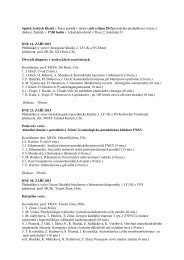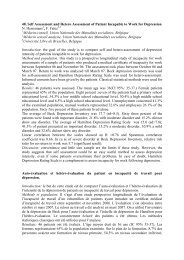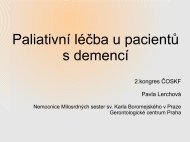ABSTRACTS â ORAL PRESENTATIONS - AMCA, spol. s r.o.
ABSTRACTS â ORAL PRESENTATIONS - AMCA, spol. s r.o.
ABSTRACTS â ORAL PRESENTATIONS - AMCA, spol. s r.o.
You also want an ePaper? Increase the reach of your titles
YUMPU automatically turns print PDFs into web optimized ePapers that Google loves.
extrinsic type of apoptosis, associated with an increase in DR5 expression, the formation<br />
of DR5-containing death inducing signaling complex (DISC) and subsequent activation of<br />
caspase-8. Supportive evidences were generated by stable overexpression of FADD-DN<br />
(FAS-associating death domain-containing protein-dominant negative) or c-FLIP (cellular<br />
FLICE-like inhibitory protein), potent inhibitors of DISC aggregation. A similar but<br />
significantly delayed death signaling pathway was observed in HCT116 cells lacking p53,<br />
as demonstrated by less prominent specific cleavage of caspases and PARP, and reduced<br />
mitochondrial release of cytochrome c, compared to their p53 expressing counterparts.<br />
More recently, we have focused on the primary trigger point of FU and our preliminary<br />
data indicate that the elicited death response is emerging from transcriptional but not<br />
from DNA lesions in some CRC cell lines. We believe that FU indeed misincorporates into<br />
DNA but fails to induce a stress response. Therefore, current aims involve modulation of<br />
DNA-repair systems in order to further augment cell death by stimulating DNA stress in<br />
parallel to RNA toxicity. Interestingly, in FU-treated cells suppression of PARP activity, an<br />
important factor in base excision repair, specifically induces DNA damage and enhances<br />
apoptosis in p53 deficient HCT116 cells. This response pattern has been verified also<br />
in other cell systems. In conclusion, lack of p53 reduces the apoptotic response to FU<br />
alone but allows for sensitivity to combinatorial treatment including a PARP inhibitor.<br />
Ongoing experiments are trying to reveal the molecular mechanism underlying these<br />
observations.<br />
57. RELATIVE BIOLOGICAL EFFICIENCY OF PROTONS AT LOW AND THERAPEUTIC<br />
DOSES IN INDUCTION OF γH2AX FOCI AND APOPTOSIS<br />
Lucian Zastko 1,2 , S. Sorokina 2,3 , P. Plavckova 1,2 , E. Markova 2 , J. Gursky 2 , J. Dobrovodsky 4 ,<br />
I. Y. Belyaev 2<br />
1<br />
Proton Therapy Complex, Central Military Hospital, Ružomberok, Slovak Republic;<br />
2<br />
Cancer Research Institute, Slovak Academy of Sciences, Bratislava,<br />
Slovak Republic; exonzast@savba.sk<br />
3<br />
Institute of Theoretical and Experimental Biophysics, Russian Academy of Science,<br />
Pushchino, Russia<br />
4<br />
Slovak Institute of Metrology, Bratislava, Slovak Republic<br />
Currently, the radiation therapy of tumors is mostly performed with high-energy photon<br />
beams generated by clinical linear electron accelerators. High-energy proton or ion<br />
beams have recently been advanced as a promising alternative to photon radiotherapy<br />
treatment and is a rapidly emerging treatment modality. The unique properties of<br />
protons, which lose their energy forming a Bragg peak, enable precise delivery of a high<br />
dose of radiation to the tumor region, while also sparing critical organs and healthy<br />
tissues. However, this type of radiotherapy has not been widely accepted mainly because<br />
of high costs and related secondary neutron irradiation associated with increased risks<br />
of secondary cancers (Sorokina et al., 2013).<br />
New ProTom proton therapy technology, which may overcome some major obstacles<br />
Analytical Cytometry VII 71








